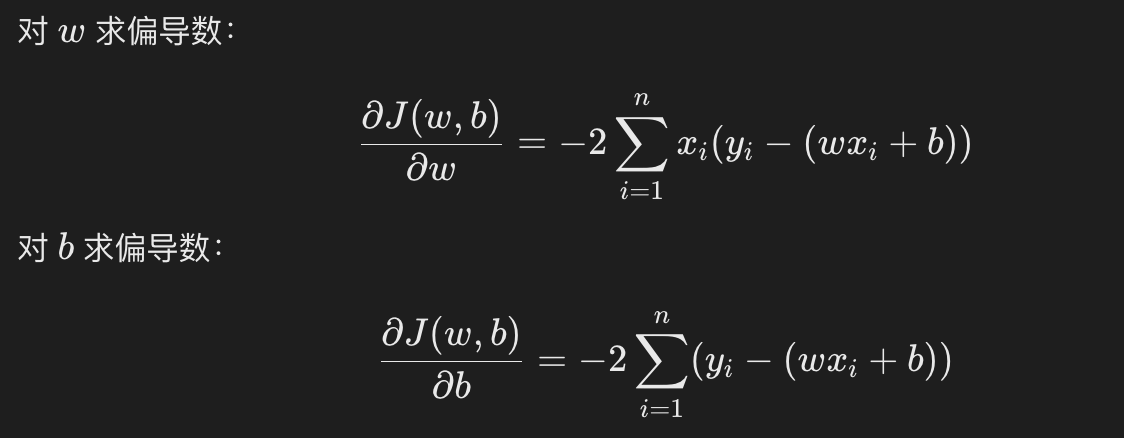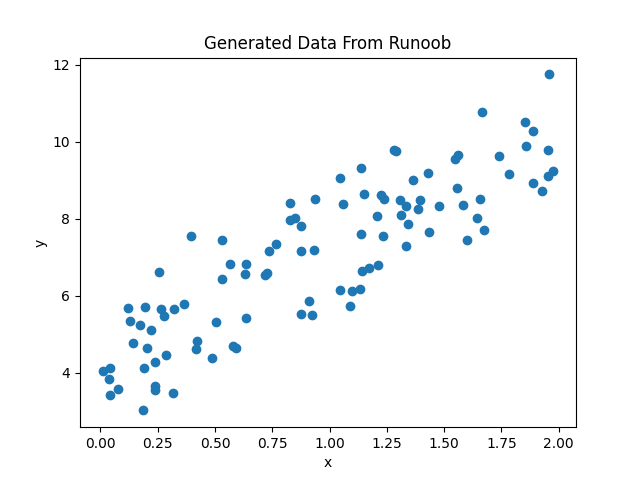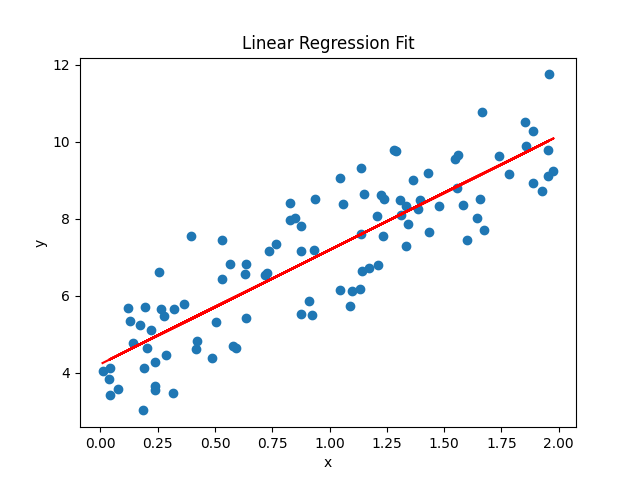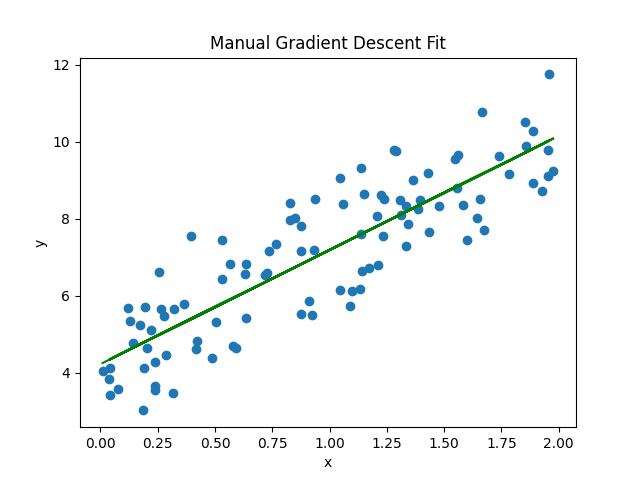线性回归 (Linear Regression)
线性回归(Linear Regression)是机器学习中最基础且广泛应用的算法之一。
线性回归 (Linear Regression) 是一种用于预测连续值的最基本的机器学习算法,它假设目标变量 y 和特征变量 x 之间存在线性关系,并试图找到一条最佳拟合直线来描述这种关系。
y = w * x + b
其中:
y是预测值x是特征变量w是权重 (斜率)b是偏置 (截距)
线性回归的目标是找到最佳的 w 和 b,使得预测值 y 与真实值之间的误差最小。常用的误差函数是均方误差 (MSE):
MSE = 1/n * Σ(y_i - y_pred_i)^2
其中:
- y_i 是实际值。
- y_pred_i 是预测值。
- n 是数据点的数量。
我们的目标是通过调整 w 和 b ,使得 MSE 最小化。
如何求解线性回归?
1、最小二乘法
最小二乘法是一种常用的求解线性回归的方法。它通过求解以下方程来找到最佳的 ( w ) 和 ( b ):

2、梯度下降法
梯度下降法是一种迭代优化算法,用于最小化损失函数(如 MSE)。
它的基本思想是通过不断调整 w 和 b 的值,使得损失函数逐渐减小。

梯度下降的更新规则为:

其中:
- a 是学习率,控制每次更新的步长。
使用 Python 实现线性回归
下面我们通过一个简单的例子来演示如何使用 Python 实现线性回归。
1、导入必要的库
实例
import numpy as np
import matplotlib.pyplot as plt
from sklearn.linear_model import LinearRegression
import matplotlib.pyplot as plt
from sklearn.linear_model import LinearRegression
2、生成模拟数据
实例
import numpy as np
import matplotlib.pyplot as plt
from sklearn.linear_model import LinearRegression
# 生成一些随机数据
np.random.seed(0)
x = 2 * np.random.rand(100, 1)
y = 4 + 3 * x + np.random.randn(100, 1)
# 可视化数据
plt.scatter(x, y)
plt.xlabel('x')
plt.ylabel('y')
plt.title('Generated Data From Runoob')
plt.show()
import matplotlib.pyplot as plt
from sklearn.linear_model import LinearRegression
# 生成一些随机数据
np.random.seed(0)
x = 2 * np.random.rand(100, 1)
y = 4 + 3 * x + np.random.randn(100, 1)
# 可视化数据
plt.scatter(x, y)
plt.xlabel('x')
plt.ylabel('y')
plt.title('Generated Data From Runoob')
plt.show()
显示如下所示:

3、使用 Scikit-learn 进行线性回归
实例
import numpy as np
import matplotlib.pyplot as plt
from sklearn.linear_model import LinearRegression
# 生成一些随机数据
np.random.seed(0)
x = 2 * np.random.rand(100, 1)
y = 4 + 3 * x + np.random.randn(100, 1)
# 创建线性回归模型
model = LinearRegression()
# 拟合模型
model.fit(x, y)
# 输出模型的参数
print(f"斜率 (w): {model.coef_[0][0]}")
print(f"截距 (b): {model.intercept_[0]}")
# 预测
y_pred = model.predict(x)
# 可视化拟合结果
plt.scatter(x, y)
plt.plot(x, y_pred, color='red')
plt.xlabel('x')
plt.ylabel('y')
plt.title('Linear Regression Fit')
plt.show()
import matplotlib.pyplot as plt
from sklearn.linear_model import LinearRegression
# 生成一些随机数据
np.random.seed(0)
x = 2 * np.random.rand(100, 1)
y = 4 + 3 * x + np.random.randn(100, 1)
# 创建线性回归模型
model = LinearRegression()
# 拟合模型
model.fit(x, y)
# 输出模型的参数
print(f"斜率 (w): {model.coef_[0][0]}")
print(f"截距 (b): {model.intercept_[0]}")
# 预测
y_pred = model.predict(x)
# 可视化拟合结果
plt.scatter(x, y)
plt.plot(x, y_pred, color='red')
plt.xlabel('x')
plt.ylabel('y')
plt.title('Linear Regression Fit')
plt.show()
输出结果:
斜率 (w): 2.968467510701019 截距 (b): 4.222151077447231
显示如下所示:

我们可以使用 score() 方法来评估模型性能,返回 R^2 值。
实例
import numpy as np
from sklearn.linear_model import LinearRegression
# 生成一些随机数据
np.random.seed(0)
x = 2 * np.random.rand(100, 1)
y = 4 + 3 * x + np.random.randn(100, 1)
# 创建线性回归模型
model = LinearRegression()
# 拟合模型
model.fit(x, y)
# 计算模型得分
score = model.score(x, y)
print("模型得分:", score)
from sklearn.linear_model import LinearRegression
# 生成一些随机数据
np.random.seed(0)
x = 2 * np.random.rand(100, 1)
y = 4 + 3 * x + np.random.randn(100, 1)
# 创建线性回归模型
model = LinearRegression()
# 拟合模型
model.fit(x, y)
# 计算模型得分
score = model.score(x, y)
print("模型得分:", score)
输出结果为:
模型得分: 0.7469629925504755
4、手动实现梯度下降法
实例
import numpy as np
import matplotlib.pyplot as plt
from sklearn.linear_model import LinearRegression
# 生成一些随机数据
np.random.seed(0)
x = 2 * np.random.rand(100, 1)
y = 4 + 3 * x + np.random.randn(100, 1)
# 初始化参数
w = 0
b = 0
learning_rate = 0.1
n_iterations = 1000
# 梯度下降
for i in range(n_iterations):
y_pred = w * x + b
dw = -(2/len(x)) * np.sum(x * (y - y_pred))
db = -(2/len(x)) * np.sum(y - y_pred)
w = w - learning_rate * dw
b = b - learning_rate * db
# 输出最终参数
print(f"手动实现的斜率 (w): {w}")
print(f"手动实现的截距 (b): {b}")
# 可视化手动实现的拟合结果
y_pred_manual = w * x + b
plt.scatter(x, y)
plt.plot(x, y_pred_manual, color='green')
plt.xlabel('x')
plt.ylabel('y')
plt.title('Manual Gradient Descent Fit')
plt.show()
import matplotlib.pyplot as plt
from sklearn.linear_model import LinearRegression
# 生成一些随机数据
np.random.seed(0)
x = 2 * np.random.rand(100, 1)
y = 4 + 3 * x + np.random.randn(100, 1)
# 初始化参数
w = 0
b = 0
learning_rate = 0.1
n_iterations = 1000
# 梯度下降
for i in range(n_iterations):
y_pred = w * x + b
dw = -(2/len(x)) * np.sum(x * (y - y_pred))
db = -(2/len(x)) * np.sum(y - y_pred)
w = w - learning_rate * dw
b = b - learning_rate * db
# 输出最终参数
print(f"手动实现的斜率 (w): {w}")
print(f"手动实现的截距 (b): {b}")
# 可视化手动实现的拟合结果
y_pred_manual = w * x + b
plt.scatter(x, y)
plt.plot(x, y_pred_manual, color='green')
plt.xlabel('x')
plt.ylabel('y')
plt.title('Manual Gradient Descent Fit')
plt.show()
输出结果:
手动实现的斜率 (w): 2.968467510701028 手动实现的截距 (b): 4.222151077447219
显示如下所示:


点我分享笔记